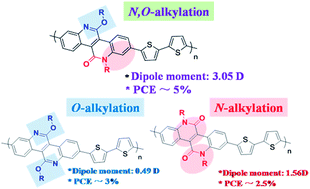Our official English website, www.x-mol.net, welcomes your
feedback! (Note: you will need to create a separate account there.)
N-Alkylation vs. O-alkylation: influence on the performance of the photovoltaic cells based on a tetracyclic lactam polymer donor†
RSC Advances ( IF 3.9 ) Pub Date : 2019-04-18 00:00:00 , DOI: 10.1039/c9ra01545k Chenchen Li 1, 2 , Mian Cai 2, 3 , Xichang Bao 2 , Yanfang Liu 2 , Renqiang Yang 2 , Xiaobo Wan 1, 2
RSC Advances ( IF 3.9 ) Pub Date : 2019-04-18 00:00:00 , DOI: 10.1039/c9ra01545k Chenchen Li 1, 2 , Mian Cai 2, 3 , Xichang Bao 2 , Yanfang Liu 2 , Renqiang Yang 2 , Xiaobo Wan 1, 2
Affiliation

|
Lactam-containing acceptors, which could provide two potential alkylation positions (N-alkylation and O-alkylation), are important building blocks for polymeric donors in high performance polymer solar cells (PSCs). However, the influence of alkylation positions on the PSC performance has seldom been studied. Herein, we investigated the influence of O-alkylation and N-alkylation on a novel bislactam acceptor, namely dibenzonaphthyridinedione (DBND), on the physical properties of the corresponding polymers and hence their PSC performance. Besides O-alkylated and N-alkylated DBND, half-N-alkylated-half-O-alkylated DBND (N,O-DBND) was also prepared and copolymerized with stannyl bithiophene (2T). It was found that by varying the alkylation positions, the optical, crystalline and aggregation properties of the corresponding polymers were greatly altered. In comparison with P(N-DBND-2T) and P(O-DBND-2T), P(N,O-DBND-2T) shows both better solubility and shorter π–π stacking distance. By blending with PC71BM, P(N,O-DBND-2T) forms better nano-fibrillar phase separation so that less charge recombination is observed, thus leading to a much better power conversion efficiency (PCE) around 5%, which is the highest value of the conjugated system based on N,O-alkylated acceptors. The results show that the asymmetric N,O-alkylation protocol is a promising way to adjust the properties of the bislactam-containing conjugated polymers.
中文翻译:

N-烷基化与 O-烷基化:对基于四环内酰胺聚合物供体的光伏电池性能的影响†
含有内酰胺的受体可以提供两个潜在的烷基化位置(N-烷基化和O-烷基化),是高性能聚合物太阳能电池 (PSC) 中聚合物供体的重要组成部分。然而,很少研究烷基化位置对 PSC 性能的影响。在此,我们研究了O-烷基化和N-烷基化对新型双内酰胺受体二苯并萘啶二酮 ( DBND ) 对相应聚合物的物理性质及其 PSC 性能的影响。除了O-烷基化和N-烷基化DBND,半-N-烷基化-半-O还制备了-烷基化的DBND(N,O -DBND)并与甲锡烷基二噻吩(2T)共聚。发现通过改变烷基化位置,相应聚合物的光学、结晶和聚集性质发生了很大变化。与P( N -DBND-2T)和P( O -DBND-2T) 相比,P( N , O -DBND-2T)表现出更好的溶解度和更短的 π-π 堆积距离。通过与 PC 71 BM 混合,P( N , O -DBND-2T)形成更好的纳米纤丝相分离,从而观察到更少的电荷复合,从而导致更好的功率转换效率(PCE)约为 5%,这是基于N,O-烷基化受体的共轭体系的最高值。结果表明,不对称的N,O-烷基化方案是调节含双内酰胺的共轭聚合物性能的一种有前途的方法。
更新日期:2019-04-18
中文翻译:

N-烷基化与 O-烷基化:对基于四环内酰胺聚合物供体的光伏电池性能的影响†
含有内酰胺的受体可以提供两个潜在的烷基化位置(N-烷基化和O-烷基化),是高性能聚合物太阳能电池 (PSC) 中聚合物供体的重要组成部分。然而,很少研究烷基化位置对 PSC 性能的影响。在此,我们研究了O-烷基化和N-烷基化对新型双内酰胺受体二苯并萘啶二酮 ( DBND ) 对相应聚合物的物理性质及其 PSC 性能的影响。除了O-烷基化和N-烷基化DBND,半-N-烷基化-半-O还制备了-烷基化的DBND(N,O -DBND)并与甲锡烷基二噻吩(2T)共聚。发现通过改变烷基化位置,相应聚合物的光学、结晶和聚集性质发生了很大变化。与P( N -DBND-2T)和P( O -DBND-2T) 相比,P( N , O -DBND-2T)表现出更好的溶解度和更短的 π-π 堆积距离。通过与 PC 71 BM 混合,P( N , O -DBND-2T)形成更好的纳米纤丝相分离,从而观察到更少的电荷复合,从而导致更好的功率转换效率(PCE)约为 5%,这是基于N,O-烷基化受体的共轭体系的最高值。结果表明,不对称的N,O-烷基化方案是调节含双内酰胺的共轭聚合物性能的一种有前途的方法。




















































 京公网安备 11010802027423号
京公网安备 11010802027423号